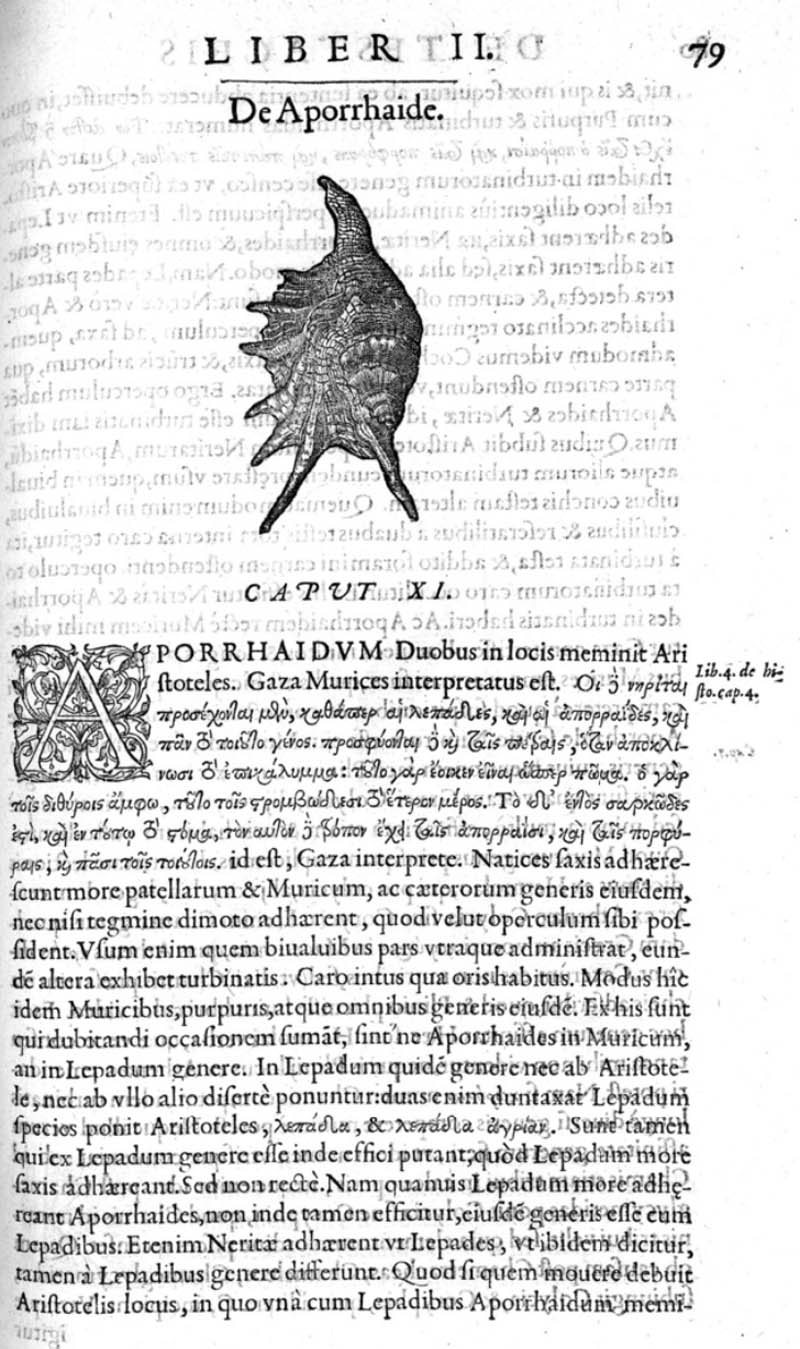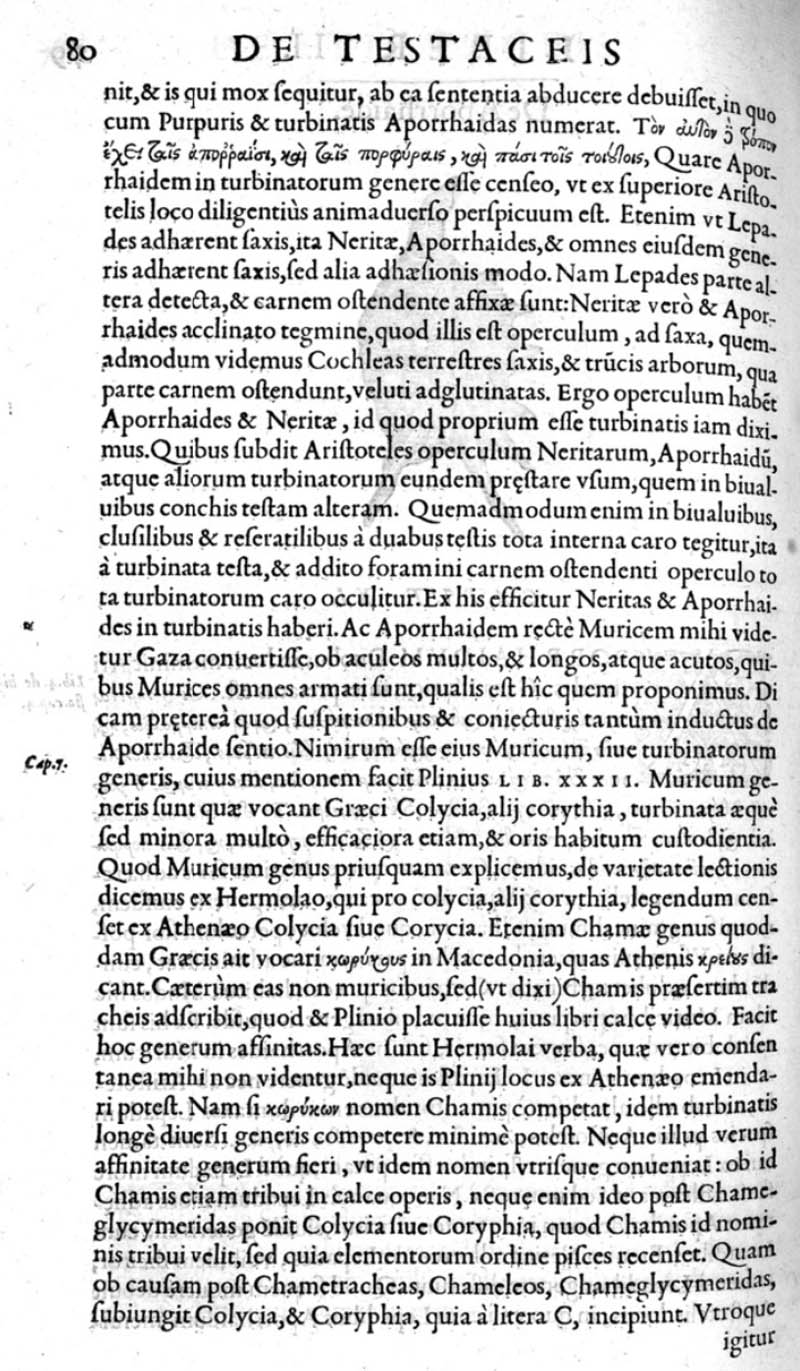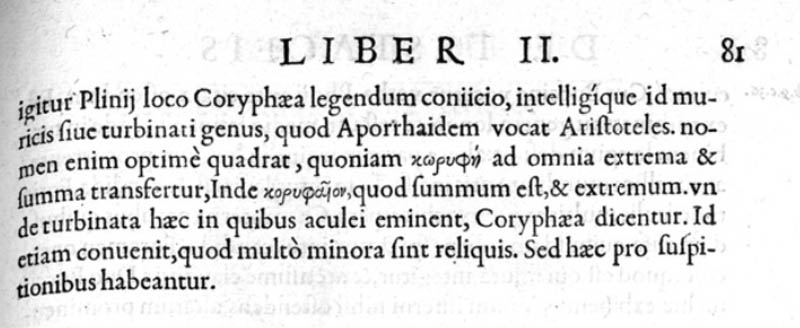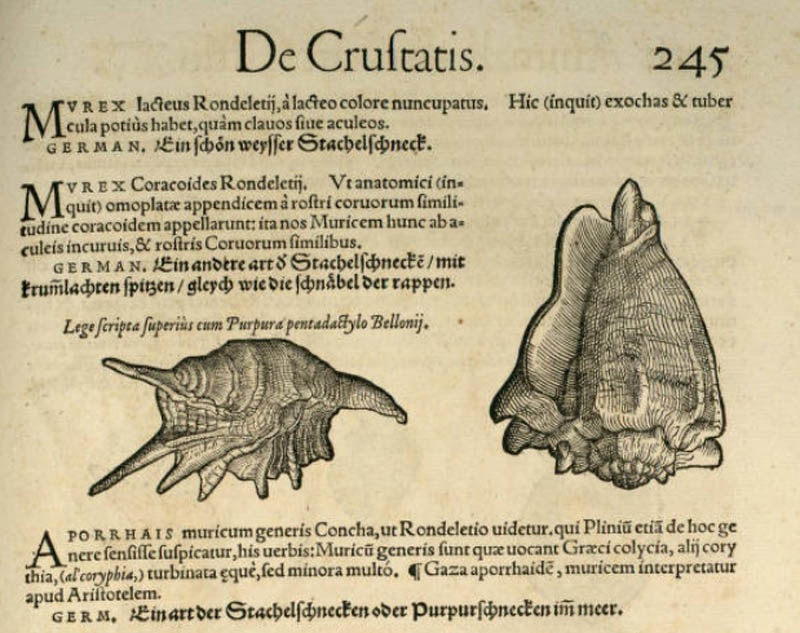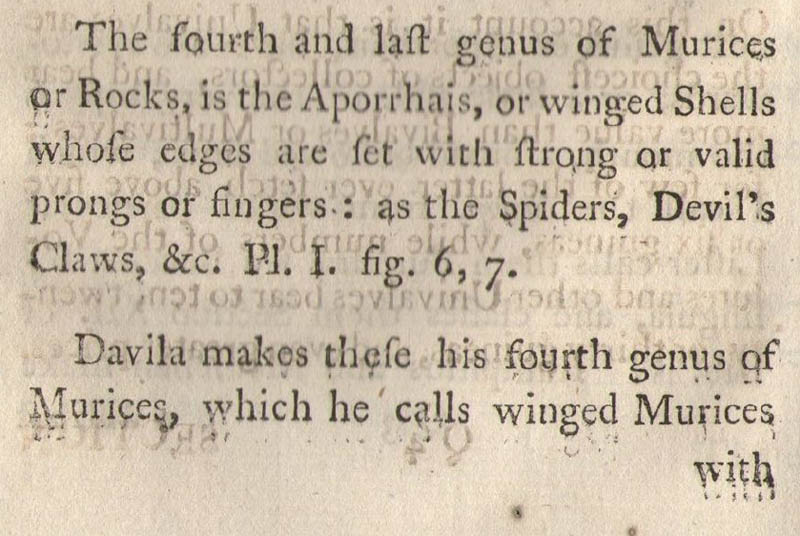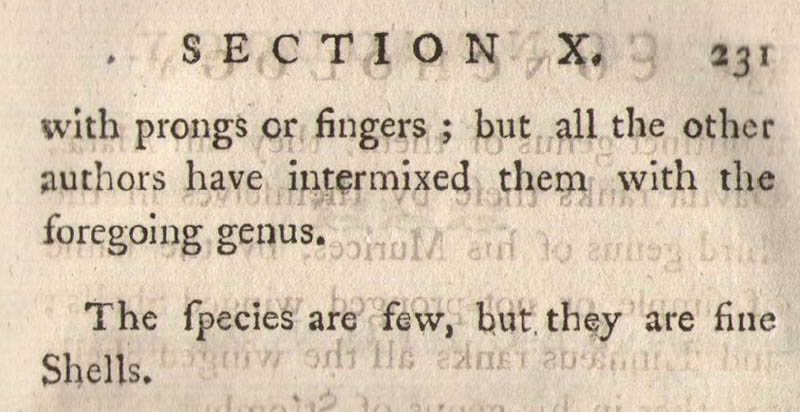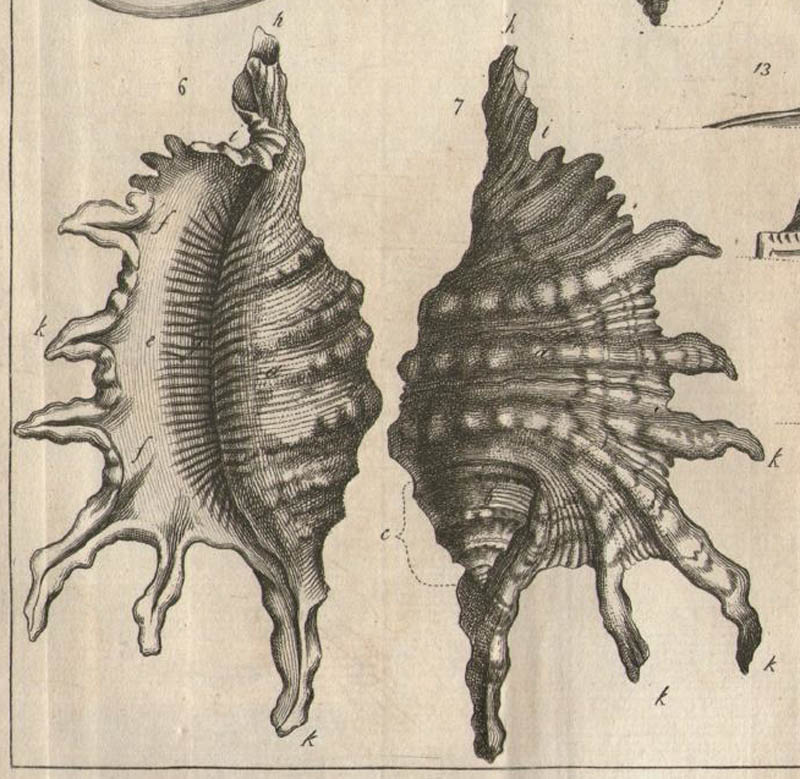|
edit SideBar
|
Stromboidea
Original Diagnosis of Aporrhais in Da Costa, 1778, p. 136:
- "Murices or Rocks, whose wing is cut into spikes or fingers."
- "Murices ou Rochers, dont l'aile est decoupée en pattes ou doigts."
Type species by original designation is Aporrhais quadrifidus (Strombus pes pelecani Linnaeus, 1758).
The Genus Aporrhais contains several species:
- Aporrhais alata (Eichwald, 1830)
- Aporrhais arabica Abbass, 1977
- Aporrhais aralensis Eichwald, 1868
- Aporrhais arrialoorensis Stoliczka, 1867
- Aporrhais biangulata (Meek & Hayden, 1856)
- Aporrhais bicarinata Koch & Boll in Koch, 1862
- Aporrhais bowerbankii (Morris, 1852)
- Aporrhais burdigalensis (d'Orbigny, 1852)
- Aporrhais callosa (Roth von Telegd, 1914)
- Aporrhais chiastus Locard, 1889
- Aporrhais clarendonensis (Wrigley, 1938)
- Aporrhais cornutus Alexeev, 1963
- Aporrhais dactylifera (Boettger, 1902)
- Aporrhais decorata Locard, 1889
- Aporrhais digitata (Roth von Telegd, 1915)
- Aporrhais dingdenensis Marquet, Grigis, & Landau, 2002
- Aporrhais drachuki Saul, 1998
- Aporrhais elegantissima Parenzan, 1970
- Aporrhais etrusca Brunetti & Forli, 2013
- Aporrhais firma Gardner, 1884
- Aporrhais gracilis von Koenen, 1885
- Aporrhais granocarinata (Traub, 1938)
- Aporrhais granulosa (Müller, 1851)
- Aporrhais haeringensis (Gümbel, 1861)
- Aporrhais hupei (Mayer, 1857)
- Aporrhais ketewanae Kharatishvili, 1952
- Aporrhais limburgensis Binkhorst, 1861
- Aporrhais luganicus Blank, 1972
- Aporrhais margerini (De Koninck, 1838)
- Aporrhais megapolitana Beyrich, 1854
- Aporrhais meridionalis (Basterot, 1825)
- Aporrhais najdini Blank, 1972
- Aporrhais nodarii Kharatishvili, 1952
- Aporrhais oxydactyla (Sandberger, 1861)
- Aporrhais peralata (Sacco, 1893)
- Aporrhais pescarbonis (Brongniart, 1823)
- Aporrhais pesgallinae Barnard, 1963
- Aporrhais pespelecani (Linnaeus, 1758)
- Aporrhais potomacensis Clark & Martin, 1901
- Aporrhais praeteritus (Boettger, 1906)
- Aporrhais pyriformis (Kner, 1850)
- Aporrhais rapax Böhm, 1891
- Aporrhais rumelicus (Toula, 1892)
- Aporrhais sauditica Ferrari & al., 2018
- Aporrhais scaldensis (van Regteren Altena, 1954)
- Aporrhais senegalensis (Gray, 1838)
- Aporrhais sera (Steininger, 1963)
- Aporrhais serresiana (Michaud, 1828)
- Aporrhais sowerbii (Fleming, 1828)
- Aporrhais speciosa (von Schlotheim, 1820)
- Aporrhais thersites (Brives, 1897)
- Aporrhais triangulata Gardner, 1884
- Aporrhais tridactyla (Braun, 1850)
- Aporrhais unisinuata (Sandberger, 1861)
- Aporrhais uttingeriana (Risso, 1826)
- Aporrhais volkovi Zhizchenko, 1959
known hybrids
unknown species:
available names
- Aporrhais aralensis Eichwald, 1868
- Aphorais gracilis Aldrich, 1886
- Chenopus anceps Sandberger, 1861
- Chenopus anglicus d'Orbigny, 1852
- Rostellaria brongniartianus Risso, 1826
- Chenopus decussatus Philippi, 1847
- Muricites gracilis von Schlotheim, 1820
- Chenopus mathiasi Noszky, 1940
- Chenopus paradoxus Philippi, 1843
- Rostellaria pesardeae Sassi, 1827
- Rostellaria tenuis Boll, 1846
History and Synonymy
- Aporrhais Da Costa, 1778:136 (TS by Monotypy: Aporrhais quadrifidus Da Costa, 1778)
- Syn.: Androvandus Woodward, 1851:129 Settepassi, 1971:I [non Woodward, 1851]
- Syn.: Aphorais Gray, 1847:270 [incorrect subsequent spelling]
- Syn.: Aphorrais Swainson, 1840 [incorrect subsequent spelling]
- Syn.: Apoorhais Conrad, 1855 [incorrect subsequent spelling]
- Syn.: Aporchais Cossmann, 1913 [incorrect subsequent spelling]
- Syn.: Aporhais Weinzettl, 1910 [incorrect subsequent spelling]
- Syn.: Aporrais Cotteau, 1868 [incorrect subsequent spelling]
- Syn.: Aporrhis Swainson, 1835 [incorrect subsequent spelling]
- Syn.: Apporhais Gray, 1852 [incorrect subsequent spelling]
- Syn.: Cenopus Strausz, 1928:234 [incorrect subsequent spelling]
- Syn.: Chenopus Philippi, 1836:214
- Syn.: Choenopus Ponzi, 1875:274 [incorrect subsequent spelling]
- Syn.: Muricites von Schlotheim, 1820:142
- Syn.: Nisaclis Nordsieck, 1972:64
- Syn.: Ornitopus Piette, 1891:504
- Syn.: Pelecanus Piette, 1876:265 [non Linnaeus, 1758]
- Syn.: Strombites von Schlotheim, 1820:155
- Syn.: Struthiodomus Coen, 1931:145 [ex MS Monterosato]
350 BC
Aristotle (350 BC), "Historia Animalium": Aristotle used Aporrhais in a way, that it is doubtful which species is meant.
- The original text by Aristotle translated by D'Arcy Wentworth Thompson: "The nerites has a smooth large round shell, and resembles the ceryx in shape, only the poppy-juice is, in its case, not black but red. It clings with great force near the middle. In calm weather, then, they go free afield, but when the wind blows the carcinia take shelter against the rocks: the neritae themselves cling fast like limpets; and the same is the case with the haemorrhoid or aporrhaid and all others of the like kind. And, by the way, they cling to the rock, when they turn back their operculum, for this operculum seems like a lid; in fact this structure represents the one part, in the stromboids, of that which in the bivalves is a duplicate shell. The interior of the animal is fleshy, and the mouth is inside. And it is the same with the haemorrhoid, the purple murex, and all suchlike animals." This text leaves space for interpretation (haemorrhoid = aporrhaid ?), since the natural habitat of Aporrhais pespelecani is not rock.
1555
Rondelet, 1555, p. 79-81
1558
Gesner, 1558, p. 245
1776
Da Costa, 1776, p. 230/231
Aporrhais Da Costa, 1776, pl. 1, figs. 6,7 and cations p. 282
1836
Philippi, 1836, p. 214:
- "Familia 19. Alata Lamk.
- Chenopus mihi.
- Testa fusiformis, basi in canalem s. potius sulcum labri desinens; labrum aetate dilatatum, angulato-lobatum, lobis intus sulcatis, supremo a spira divergente.
- Animal (Rostellariae pedis pelecani). Caput elongatum probosciforme depressum, emarginatum. Tentacula distanta filiformia, longitudine capitis, oculos in tuberculo lateris externi baseos ferentia. Collum longum. Pes parvus, oblongus, utrinque rotundatus. Pallium absque siphone, quadriangulatum; anguli (in speciminibus in alcole contractis) perparum prominentes. Branchia unica, elongata angusta. Apertura ani et oviductus loco solito; penis in latere dextro sub tentaculo ab eo 1 1/2 ´´´ distans, contractus 5 ´´´ longus. Color animalis carneus, latera rubro punctata, pars superior rubra, tentacula rubra, externe linea longitudinali alba notata."
1847
Gray, 1847:270 Aphorais [incorrect subsequent spelling]
1854
Beyrich, 1854, p. 169:
- "Aporrhais. (Chenopus Philippi.)
- Der Name Aporrhais, von Aristoteles in zweifelhafter Bedeutung gebraucht, wurde von Aldrovandi (1606 De Testaceis Cap. XIV, p. 341) einer grossen Pteroceras-Art beigelegt. Schon von Petiver wurde unter dem gleichen Namen der von Lamarck zu Rostellaria gezogene Strombus pes-pelecani Linné's begriffen, und für diesen blieb in der englischen Litteratur die Benennung Aporrhais in Gebrauch. Da Costa, Dillwyn, später Gray, Swainson und Wood hielten jenen Namen aufrecht, während in der neueren deutschen und französischen Litteratur der von Philippi gegebene Name Chenopus schnell eine allgemeine Verbreitung erlangte. Philippi hat das Verdienst, durch Beobachtung des Thieres die Notwendigkeit der Trennung des Strombus pes-pelecani und der ihm verwandten Arten von den übrigen Rostellarien Lamarck's dargethan zu haben, und billig wäre die Benennung Chenopus statt der älteren Aporrhais, welche sich nicht die gleiche allgemeine Anerkennung zu verschaffen im Stande war, beizubehalten. Doch hat Philippi selbst in seinem Handbuch der Conchyliologie den Namen Aporrhais angenommen."
2007
Diagnosis of Aporrhais by Bandel, 2007, p. 108:
- "The shell has a tall conical spire with apical angle about 35° to 40°. Its ornament consists of a median keel accompanied by a flattened upper and lower side, and spiral lines as well as collabral ribs. Often the keel bears short thickened axial ribs. On the body whorl stronger spiral ribs may be present the upper of which end in the flaring outer lip. In the fully grown shell the outer lip expands and continues into more or less flattened spines or lobes with a central groove on their inner side. The siphon may be short or long and has a similar inner groove as the spines. The protoconch is dome-shaped and in most species belonged to a planktotrophic veliger. It has about 3.5 whorls with rounded embryonic shell and the larval shell may have a fine pattern of tubercles or is smooth with fine sinuous growth lines. Transition into the teleoconch is often quite indistinct (Pl. 1/13–16).
Biology:
- Aporrhais gastropods are suspension feeders. One function of the wing is to aid the shell in filter feeding when the mollusc is buried. It forms a filtering chamber for an inhalant current entering near the anterior rostrum and an exhalant current leaving from a sinus in the posterior region of the aperture (Savazzi, 1991; Yonge, 1932)
Etymology of Aporrhais:
- "spout-shell" from aporrheo (greek) to flow away (cited after "A Manual of the Mollusca; Or, Rudimentary Treatise of Recent and Fossil Shells" by Samuel Peckworth Woodward)
- " απορρέω " to emanate, to flow out in drops, see "Elements of conchology: An Introduction to the Natural History of Shells and of the Animals ..." by Lovell Reeve, p.89
- see also Gabb, 1868
- see also "Aristoteles Thierkunde: Ein Beitrag zur Geschichte der Zoologie, Physiologie und alten Philosophie" by Jürgen Bona Meyer (1855), Google Books
- Aldrovandi (1606) used Aporrhais for a large Lambis.
- the grammatical gender of Aporrhais is feminine, see Manganelli et al. , 2008. The endings of the epithets have to be chosen according to this (see ICZN rules).
References
- H.L. Abbass, 1977. A monograph on the new Miocene gastropod species in the Cairo-Suez district, Egypt, J. Univ. Kuwait (Sci.) 4, 1977, p. 83-157.
- Mariel Ferrari, Magdy El-Hedeny, Mohamed Zakhera, Ahmed El-Sabbagh & Saleh Al Farraj (2018) Middle–Upper Jurassic marine gastropods from central Saudi Arabia, Alcheringa: An Australasian Journal of Palaeontology, DOI: 10.1080/03115518.2018.1465996
- Gabb, 1868
- Gray, 1847
- Manganelli et al., 2008
- E.v.Martens, 1860. Die classischen Conchylien-Namen, Jahreshefte des Vereins für vaterländische Naturkunde in Württemberg, 16, 175-264, Fulltext
- Guiseppe Ponzi, 1875. Atti Undecima Riunione degli Scienziati Italiani, Roma, Tip. G.B. Paravia, 1875, 11, 274, Fulltext
- Savazzi, 1991
- L. Strausz, 1928. Geologische Fazieskunde; A Magyar Állami Földtani Intézet évkönyve [Mitteilungen aus dem Jahrbuch der Kgl. ungar. Geolog. Anstalt. Annales Instituti Regii Hungarici Geologici], 28, 73-272.
- Wieneke, U. & Liverani, V. 2019. Review of the Recent Endemic West African Aporrhaidae (Gastropoda: Stromboidea), with the re-establishment of Aporrhais elegantissima PARENZAN, 1970 and records of putative hybridization in the genus Aporrhais; Conchylia 50(1-4), 147-162
- Yonge, 1932)
|

